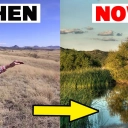
Southern Arizona is known for its desert climate, with very hot summers and mild winters. This climate has meant the region has been a hub for agricultural growth for thousands of years despite the fact rainfall has always been relatively low. It's Arizona's rivers and aquifers that hold groundwater which have supported the state’s now $23 billion agriculture industry. In terms of revenue generated, Arizona's top five agricultural products are cattle, calves, lettuce, dairy products, cotton, and hay. In total, farmland makes up about 35% of the state of Arizona. Farming in the desert has been a challenge for Arizona’s modern farmers, who grow water-intensive crops like cotton, alfalfa and corn for cows. It's estimated that these farms use nearly three-quarters of the available water supply to irrigate their crops.
The Colorado River system, which supplies 36 percent of Arizona's total water use has experienced extensive drought conditions for the past 19 years. This has resulted in Lake Mead dropping to historically low reservoir levels. More than one-third of Arizona’s water flows up the Colorado River to Lake Mead. This year an intensifying drought and declining reservoir levels across the Western United States has prompted the first-ever water supply cuts to Arizona farmers.
Extensive droughts and dwindling water supplies have wreaked havoc on the once prosperous farms that could endure the arid conditions. Arizona has also become one the fastest growing states in the last decade, as result there has been a demand for tree lined neighborhoods, golf courses and lawns, all of which require vast amounts of water. As we keep consuming the ancient groundwater, without it being replenished, water tables drop and rivers start to dry up.
However over the last 30 years Arizona has been turning this around, in this video we will show you how a low cost innovative water retention system is being used in the desert, turning the dry landscape into a fertile carbon sink stretching over 100,000 acres and we will show you how this system is recharging the aquifers, by improving water retention by at least 28% which has helped to increase biodiversity, turning the desert back into a farmland oasis. Thanks to Valer Clark Austin and Josiah Austin restoring the watershed in the Chiricahua Desert in Arizona and Mexico.
You can find out more by visiting the Cuenca Los Ojos foundation webpage.
_________________________
🔔 SUBSCRIBE with Bell notification ON
✍ ENQUIRES contact: leafoflifefilms@gmail.com
_________________________
🌳 More Greening the Desert Projects: https://youtube.com/playlist?list=PLLtXoNe4rALfFUt8garOAP5EbKwtKXCRh
_________________________
💚 SUPPORT THE CHANNEL
Help us share more regenerative stories:
https://www.patreon.com/leafoflifefilms
One time donation:
https://www.paypal.com/paypalme/LeafofLifefilms
_________________________
This video is for education and research purposes
If you are the owner of any of the images please contact us an we can credit or remove the image, THANK YOU
FAIR USE COPYRIGHT NOTICE
The Copyright Laws of the United States recognizes a “fair use” of copyrighted content. Section 107 of the U.S. Copyright Act states:
“NOTWITHSTANDING THE PROVISIONS OF SECTIONS 106 AND 106A, THE FAIR USE OF A COPYRIGHTED WORK, INCLUDING SUCH USE BY REPRODUCTION IN COPIES OR PHONORECORDS OR BY ANY OTHER MEANS SPECIFIED BY THAT SECTION, FOR PURPOSES SUCH AS CRITICISM, COMMENT, NEWS REPORTING, TEACHING (INCLUDING MULTIPLE COPIES FOR CLASSROOM USE), SCHOLARSHIP, OR RESEARCH, IS NOT AN INFRINGEMENT OF COPYRIGHT.”
THIS VIDEO AND OUR YOUTUBE CHANNEL IN GENERAL MAY CONTAIN CERTAIN COPYRIGHTED WORKS THAT WERE NOT SPECIFICALLY AUTHORIZED TO BE USED BY THE COPYRIGHT HOLDER(S), BUT WHICH WE BELIEVE IN GOOD FAITH ARE PROTECTED BY FEDERAL LAW AND THE FAIR USE DOCTRINE FOR ONE OR MORE OF THE REASONS NOTED ABOVE.
IF YOU HAVE ANY SPECIFIC CONCERNS ABOUT THIS VIDEO OR OUR POSITION ON THE FAIR USE DEFENSE, PLEASE CONTACT US IN THE COMMENTS OR SEND AN EMAIL SO WE CAN DISCUSS AMICABLY. THANK YOU.
#greeningthedesert
 LinuxWalt (@lnxw48a1) {3EB165E0-5BB1-45D2-9E7D-93B31821F864}
LinuxWalt (@lnxw48a1) {3EB165E0-5BB1-45D2-9E7D-93B31821F864}
